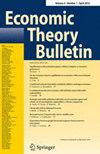稳定平衡中的转移悖论
IF 0.5
Q4 ECONOMICS
引用次数: 1
摘要
转移悖论描述的是在竞争市场中初始禀赋的转移使赠与者境况变好而(或)受赠者境况变差的情况。优势再分配、强转移悖论和奇奇尔尼斯基悖论是稳定均衡下转移悖论的三种情况,每种情况都会产生不同的福利结果。本文通过对卡尔多福利测度的应用,说明了这三个悖论之间的具体联系。本文章由计算机程序翻译,如有差异,请以英文原文为准。
Transfer paradox in a stable equilibrium
The transfer paradox describes the situation in which transfers of initial endowments within competitive market make the donor better off and (or) the recipient worse off. Advantageous redistribution, strong transfer paradox, and Chichilnisky paradox are the three cases of the transfer paradox in a stable equilibrium, wherein each case produces a different welfare outcome. This paper shows that the three paradoxes are concretely related by applying Kaldor welfare measure.
求助全文
通过发布文献求助,成功后即可免费获取论文全文。
去求助
来源期刊

Economic Theory Bulletin
ECONOMICS-
自引率
0.00%
发文量
25
期刊介绍:
The purpose of Economic Theory Bulletin is to provide an outlet for research in all areas of Economics based on rigorous theoretical reasoning. The Economic Theory Bulletin together with Economic Theory are the official journals of the Society for the Advancement of Economic Theory.
The Economic Theory Bulletin is intended to publish:
1. Short papers/notes of substantial interest. Content is subject to the same standards as Economic Theory: research in all areas of economics based on rigorous theoretical reasoning and on topics in mathematics that are supported by the analysis of economic problems. Published articles contribute to the understanding and solution of substantive economic problems. Theory papers with the substance and style for other journals that specialize in short papers are welcomed. Corollaries of already known results in the literature are not appropriate for publication.
2. Survey papers that clearly picture the basic ideas at work in the area, the essential technical apparatus that is used and the central questions that remain open.
 求助内容:
求助内容: 应助结果提醒方式:
应助结果提醒方式:


